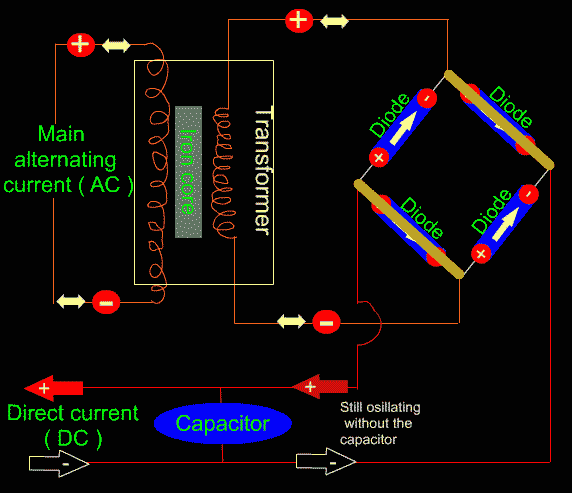There are three major kinds of power supply circuits are: unregulated (also called brute force), linear regulated, and switching.
The fourth type of power supply circuit called the ripple-regulated, is a hybrid between the “brute force” and “switching” designs, and merits a subsection to itself.
Power Supply Circuit

Unregulated
An unregulated power supply is the most rudimentary type, consisting of a transformer, rectifier, and low-pass filter. These power supplies typically exhibit a lot of ripple voltage (i.e. rapidly-varying instability) and other AC “noise” superimposed on the DC power. If the input voltage varies, the output voltage will vary by a proportional amount. The advantage of an unregulated supply is that its cheap, simple, and efficient.
See Rectifier circuits in the Diodes chapter for the various configurations of the rectifiers used in unregulated power supplies. Note that those circuits are unfiltered, A low pass filter is normally added to the output of the rectifier circuit to remove some of the ripple.
A linear regulated supply is simply a “brute force” (unregulated) power supply followed by a transistor circuit operating in its “active,” or “linear” mode, hence the name linear regulator. (Obvious in retrospect, isn’t it?)
A typical linear regulator is designed to output a fixed voltage for a wide range of input voltages, and it simply drops any excess input voltage to allow a maximum output voltage to the load. This excess voltage drop results in significant power dissipation in the form of heat.
If the input voltage gets too low, the transistor circuit will lose regulation, meaning that it will fail to keep the voltage steady. It can only drop excess voltage, not make up for a deficiency in voltage from the brute force section of the circuit.
Therefore, you have to keep the input voltage at least 1 to 3 volts higher than the desired output, depending on the regulator type. This means the power equivalent of at least 1 to 3 volts multiplied by the full load current will be dissipated by the regulator circuit, generating a lot of heat.
This makes linear regulated power supplies rather inefficient. Also, to get rid of all that heat they have to use large heat sinks which makes them large, heavy, and expensive.
Switching
A switching regulated power supply (“switcher”) is an effort to realize the advantages of both brute force and linear regulated designs (small, efficient, and cheap, but also “clean,” stable output voltage).
Switching power supplies work on the principle of rectifying the incoming AC power line voltage into DC, re-converting it into high-frequency square-wave AC through transistors operated as on/off switches, stepping that AC voltage up or down by using a lightweight transformer, then rectifying the transformer’s AC output into DC and filtering for final output.
Voltage regulation is achieved by altering the “duty cycle” of the DC-to-AC inversion on the transformer’s primary side. In addition to lighter weight because of a smaller transformer core, switchers have another tremendous advantage over the prior two designs: this type of power supply can be made so totally independent of the input voltage that it can work on any electric power system in the world; these are called “universal” power supplies.
The downside of switchers is that they are more complex, and due to their operation they tend to generate a lot of high-frequency AC “noise” on the power line. Most switchers also have significant ripple voltage on their outputs.
With the cheaper types, this noise and ripple can be as bad as for an unregulated power supply; such low-end switchers aren’t worthless, because they still provide a stable average output voltage, and there’s the “universal” input capability.
Expensive switchers are ripple-free and have noise nearly as low as for some a linear types; these switchers tend to be as expensive as linear supplies. The reason to use an expensive switcher instead of a good linear is if you need universal power system compatibility or high efficiency.
High efficiency, light weight, and small size are the reasons switching power supplies are almost universally used for powering digital computer circuitry.
Ripple Regulated
A ripple-regulated power supply is an alternative to the linear regulated design scheme: a “brute force” power supply (transformer, rectifier, filter) constitutes the “front end” of the circuit, but a transistor operated strictly in its on/off (saturation/cutoff) modes transfers DC power to a large capacitor as needed to maintain the output voltage between a high and a low setpoint.
As in switchers, the transistor in a ripple regulator never passes current while in its “active,” or “linear,” mode for any substantial length of time, meaning that very little energy will be wasted in the form of heat.
However, the biggest drawback to this regulation scheme is the necessary presence of some ripple voltage on the output, as the DC voltage varies between the two voltage control setpoints. Also, this ripple voltage varies in frequency depending on load current, which makes final filtering of the DC power more difficult.
Ripple regulator circuits tend to be quite a bit simpler than switcher circuitry, and they need not handle the high power line voltages that switcher transistors must handle, making them safer to work on.
